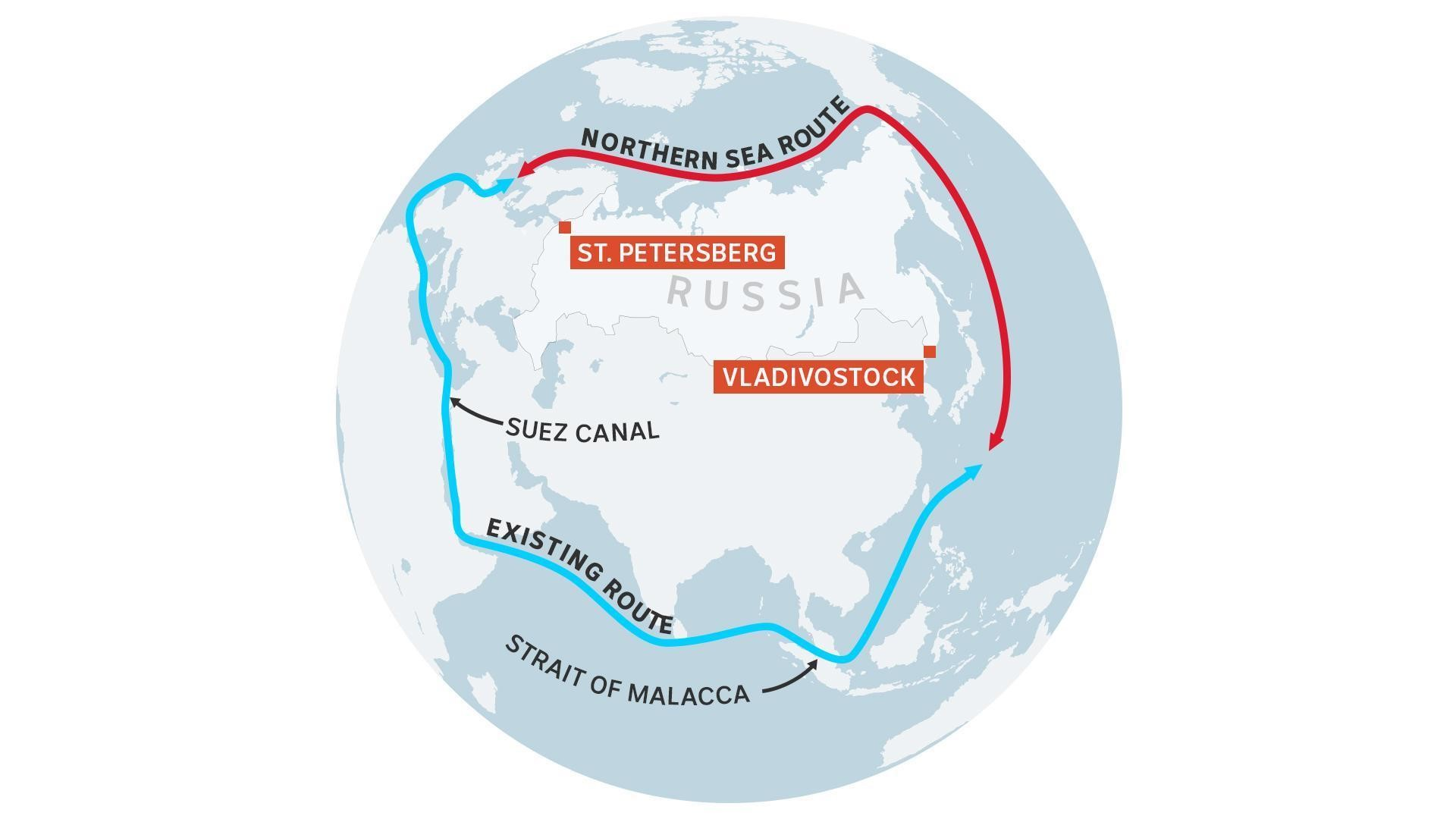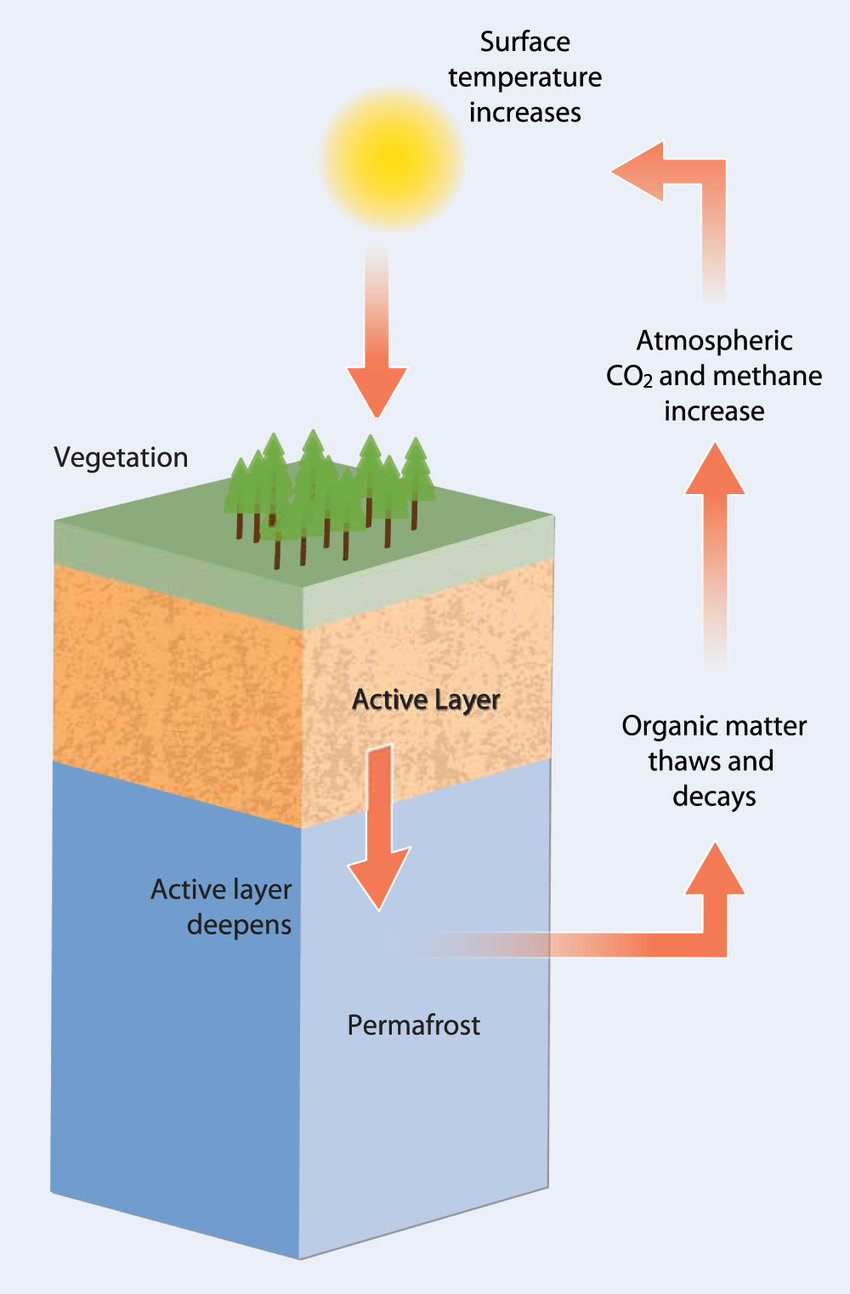India and the Arctic Opportunity
This editorial is based on “Exploring India’s potential in the Arctic region” which was published in The Hindu on 23/04/2025. The article brings into picture the strategic trade opportunity emerging from the Northern Sea Route due to Arctic melting
For Prelims: Arctic's Significance, Northern Sea Route, INSTC (International North-South Transport Corridor), Suez Canal, Critical Mineral Mission, United Nations Convention on the Law of the Sea, Himadri Research Station.
For Mains: Significance of the Arctic Region for India, Critical Issues Presently Affecting the Arctic Region.
As global trade patterns shift amid geopolitical tensions and climate change, the Arctic's melting ice is opening the Northern Sea Route (NSR), a potential game-changer linking Europe and Asia that promises significant time and cost savings. India, with its early Arctic engagement through the Svalbard Treaty and research base Himadri, has recognized this opportunity in its 2022 Arctic policy, but must now focus on practical implementation including shipbuilding capabilities suited for harsh Arctic conditions. The 2025-26 Budget's $3 billion Maritime Development Fund and promotion of shipbuilding clusters marks a positive step.
What is the Significance of the Arctic Region for India?
- Climate Change and Impact on India’s Monsoon: The Arctic plays a critical role in global climate systems, and its rapid warming directly impacts India’s monsoon patterns, which are vital for its agriculture and water security.
- Rising Arctic temperatures disrupt atmospheric circulation, leading to unpredictable monsoons, which can hurt food production.
- For instance, recent research reveals that less sea ice in the central Arctic leads to lower rain in western and peninsular India but more rain in central and northern India.
- The Arctic has warmed nearly 4 times faster than the rest of the planet during the last 40 years, and further warming may exacerbate these shifts in monsoon patterns.
- Access to Arctic Hydrocarbons: India's energy security is deeply tied to Arctic resources, particularly oil and natural gas, with the region holding 13% of the world’s undiscovered oil and 30% of its gas reserves.
- As India looks to diversify its energy sources, access to these resources becomes increasingly critical amidst fluctuating global energy prices.
- India's energy deals with Russia, including the Sakhalin-I and Vankorneft projects, represent growing involvement in Arctic hydrocarbon exploration.
- Russia, with its vast Arctic reserves, has already started supplying significant amounts of oil to India where it became India’s top supplier.
- Strategic Maritime Routes and Shipping: The opening of the Northern Sea Route (NSR) due to melting ice offers a shorter and more cost-effective path between Europe and Asia, which is crucial for India’s trade interests.
- This route, bypassing traditional chokepoints like the Suez Canal, could significantly reduce shipping time and costs, fostering better economic ties.
- Increased NSR traffic, which rose to 37.9 million tonnes in 2024, underscores its growing importance for global trade.
- The INSTC (International North-South Transport Corridor), which connects India to the Arctic via Russia, is also poised to enhance India's trade with European and Central Asian markets.
- Access to Critical Minerals: The Arctic’s mineral wealth, including rare earth metals, could be pivotal to India’s 'Make in India' and technological ambitions.
- The region hosts deposits of critical minerals like rare earths, vital for electronics and defense systems.
- With rare earth minerals being found in Greenland, India’s future economic growth, particularly in tech and defense through the National Critical Mineral Mission, is linked to access to these resources.
- Scientific Collaboration and Research Opportunities: India’s Himadri Research Station in Svalbard and the growing scientific collaborations with Arctic nations position India as a key player in global climate research.
- The Himalayan region, often called the "Third Pole," shares notable similarities with the Arctic, offering India valuable insights into its own high-altitude ecosystems.
- The recent India-Norway cooperation on climate change research demonstrates India's active role in exploring the links between Arctic melting and climate anomalies in the tropics, particularly on the Indian subcontinent.
What are the Critical Issues Presently Affecting the Arctic Region?
- Accelerating Climate Change and Environmental Degradation: The Arctic region is warming at a rate 4 times faster than the global average, contributing to rapid ice melt and rising sea levels, which have significant global environmental consequences.
- This warming accelerates feedback loops, such as the release of methane from permafrost, further exacerbating climate change.
- Recent NASA data shows that Arctic sea ice is now shrinking at a rate of 12.2% per decade, and scientists warn that the Arctic could be ice-free in the summer by 2050.
- The permafrost thaw is releasing significant amounts of greenhouse gases, accelerating global warming.
- Geopolitical Tensions and Territorial Disputes: The Arctic is becoming a major geopolitical hotspot, with increasing territorial disputes among Arctic states over resource extraction rights and sea routes.
- As climate change opens new shipping lanes, competition between nations like Russia, Canada, and the U.S. intensifies, especially over the Northern Sea Route (NSR) and the continental shelf.
- The U.S. and Russia have ongoing disagreements over the Northwest Passage, which Canada claims as internal waters.
- Russia’s military presence in the Arctic has expanded, heightening tensions with NATO countries and other Arctic nations.
- Resource Extraction and Environmental Risks: The Arctic holds vast reserves of untapped resources, making it a prime target for economic exploitation.
- However, the region's fragile ecosystem means that exploitation carries significant risks, including oil spills and habitat destruction.
- As Arctic sea routes open up, resource extraction will increase, with companies like ExxonMobil already investing heavily, raising concerns over sustainability.
- Lack of Comprehensive International Governance: Despite the importance of the Arctic, there is no overarching international legal framework to govern the region’s resources and environmental protection comprehensively.
- The Arctic Council, while instrumental, lacks enforcement powers, and territorial disputes remain unresolved.
- The United Nations Convention on the Law of the Sea (UNCLOS) provides some structure, but many Arctic states continue to assert conflicting territorial claims, complicating global governance efforts.
- China’s Growing Presence and Arctic Ambitions: China has increasingly asserted itself as a "Near-Arctic State" and has deepened its involvement in Arctic affairs through investments and partnerships with Arctic nations.
- This has raised concerns among India and the West about China’s strategic ambitions in the region, especially regarding access to Arctic resources and shipping routes.
- China’s Polar Silk Road initiative seeks to secure access to the Northern Sea Route, bypassing traditional chokepoints like the Malacca Strait, has shifted the balance of power in the region.
- Impact of the Ukraine War on Arctic Cooperation: The ongoing conflict in Ukraine has disrupted cooperation in the Arctic, particularly within the Arctic Council, where key member states suspended collaboration with Russia following its invasion.
- This has led to a halt in many joint scientific research projects and environmental initiatives that are crucial for understanding and mitigating climate change.
- Russia’s isolation from the Arctic Council has hindered important data sharing and scientific research, particularly on permafrost and Arctic warming, which are essential for global climate models.
What Role can India Assume in Promoting Sustainable and Responsible Exploration in the Arctic Region?
- Strengthening Arctic Scientific Research and Collaboration: India can expand its role by enhancing collaborative research in the Arctic, particularly in the areas of climate change, glaciology, and ecosystem monitoring.
- By increasing investment in polar research infrastructure, such as expanding the Himadri Research Station, India can actively contribute to global scientific understanding.
- Partnering with Arctic nations and international scientific bodies will allow India to play a crucial role in collecting and sharing data on environmental changes.
- Advocating for an Arctic Resource Governance Framework: India can take a leadership role in advocating for a binding, rules-based governance framework for the sustainable and responsible exploitation of Arctic resources.
- By pushing for international agreements under the Arctic Council that regulate resource extraction while prioritizing environmental sustainability, India can help ensure that Arctic development respects both the region's unique ecosystem and the rights of indigenous communities.
- Proactively engaging in dialogues about eco-friendly mining practices and carbon-neutral energy projects can help build consensus for long-term preservation.
- Promoting Green Energy Initiatives in the Arctic: India can lead efforts to promote renewable energy technologies in the Arctic by leveraging its expertise in solar and wind energy.
- Through collaboration with Arctic nations, India can help introduce green energy solutions that minimize the environmental impact of resource extraction and transportation.
- Initiatives like setting up joint renewable energy projects for Arctic communities and research stations can not only contribute to sustainable development but also support India's climate commitments under the Paris Agreement.
- Fostering Environmental Diplomacy for Climate Resilience: India can champion environmental diplomacy by building coalitions with other non-Arctic states, particularly within BRICS, ASEAN, and G20, to influence international policy on Arctic climate change.
- By facilitating multilateral forums on Arctic resilience, India can ensure that the region's environmental concerns are addressed in global climate negotiations.
- India's strong diplomatic reach can be used to push for the inclusion of Arctic-specific adaptation strategies in international climate frameworks..
- Implementing Arctic-Adapted Sustainability Standards: India can support the creation of Arctic-adapted sustainability standards that focus on protecting fragile ecosystems while enabling responsible exploration.
- These standards could address areas such as ship navigation through ice-covered waters, safe extraction of resources, and the protection of Arctic biodiversity.
- Leading Initiatives on Arctic Indigenous Rights Protection: India can push for stronger indigenous rights protection within the framework of Arctic governance, ensuring that indigenous communities have a say in the sustainable use of Arctic resources.
- India’s experience in democratic governance and inclusive policymaking can be leveraged to advocate for fair compensation, land rights, and cultural preservation as part of Arctic development.
- By fostering partnerships between indigenous peoples and international organizations, India can help create equitable and respectful pathways for resource use in the Arctic.
- Supporting Sustainable Arctic Infrastructure Development: India can engage in promoting sustainable Arctic infrastructure development that integrates green building technologies and low-carbon transportation systems.
- Collaborating with Arctic states and industries, India can help build infrastructure that minimizes environmental footprints while boosting economic opportunities for Arctic communities.
- This could include supporting eco-tourism initiatives, sustainable port development, and the implementation of smart grid systems for energy efficiency in remote Arctic regions.
Conclusion
The Arctic holds immense strategic, environmental, and economic significance for India—from shaping monsoon patterns to unlocking energy and trade routes. As global interest intensifies, India must balance its aspirations with sustainability by enhancing polar research, green technology deployment, and multilateral environmental diplomacy. Strengthening institutional capacities and advocating for a rules-based Arctic governance framework will be vital.
|
Drishti Mains Question: "The Arctic is emerging as a geopolitical and environmental hotspot, with implications far beyond the polar region." In this context, examine the strategic, environmental, and economic significance of the Arctic for India. |
UPSC Civil Services Examination Previous Year Question (PYQ)
Prelims
Q. Which of the following statements is/are correct about the deposits of ‘methane hydrate’? (2019)
- Global warming might trigger the release of methane gas from these deposits.
- Large deposits of ‘methane hydrate’ are found in Arctic Tundra and under the sea floor.
- Methane in atmosphere oxidizes to carbon dioxide after a decade or two.
Select the correct answer using the code given below.
(a) 1 and 2 only
(b) 2 and 3 only
(c) 1 and 3 only
(d) 1, 2 and 3
Ans: (d)
Mains
Q. How do the melting of the Arctic ice and glaciers of the Antarctic differently affect the weather patterns and human activities on the Earth? Explain. (2021)
Q. What are the economic significances of discovery of oil in Arctic Sea and its possible environmental consequences? (2015)



